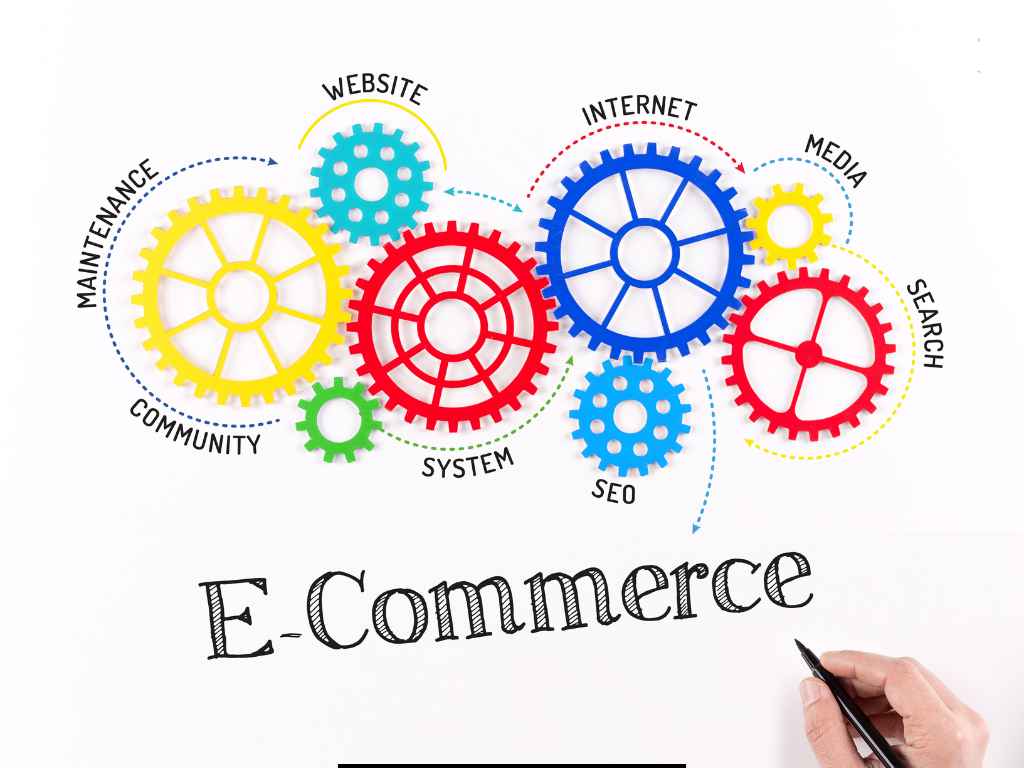When diving into building your ecommerce website, start selecting a platform such as Shopify or WooCommerce. Showcase products with transparent pricing and high-quality images for customer attraction. Guarantee a secure shopping cart for seamless transactions. Organize product listings strategically for an improved shopping experience. To lay a solid foundation, concentrate on user-friendly navigation, mobile responsiveness, and secure payment options. Also, don’t overlook prioritizing fast loading times and efficient product listings. Following these steps diligently, you will be on your way to constructing a prosperous ecommerce site poised for growth and profitability.
Key Takeaways
- Choose an ecommerce platform like Shopify or WooCommerce.
- Create captivating product listings with high-quality images.
- Ensure secure shopping cart for seamless transactions.
- Organize products for enhanced shopping experience.
- Lay a solid foundation for online store success.
Introduction to Building an Ecommerce Website

If you’re seeking to establish a thriving online store, understanding the basics of constructing an ecommerce website is fundamental. To kick off, you need to select the appropriate ecommerce platform or online store builder that fits your business needs. Platforms such as Shopify, WooCommerce, or BigCommerce provide user-friendly interfaces and customizable templates to aid you in setting up your online store efficiently.
Once you have chosen your ecommerce platform, the next step is to concentrate on creating captivating product listings. High-quality images, detailed descriptions, and clear pricing are pivotal elements to attract and retain customers. Make certain your product listings are well-organized and easy to navigate to enhance the shopping experience.
Incorporating a secure and user-friendly shopping cart is another essential aspect of constructing your ecommerce website. Customers should be able to add products, view their cart, and proceed to checkout seamlessly. A dependable shopping cart system ensures a smooth transaction process, reducing cart abandonment rates and increasing sales. When focusing on these details, you can lay a solid foundation for the success of your online store.
Why You Need an Ecommerce Website for Your Business?

Having an ecommerce website for your business is no longer just an option but a necessity in today’s digital age. In order to stay competitive and reach a broader audience, having an online presence is essential. With an ecommerce website, you can showcase your products or services to a global customer base 24/7, allowing for increased visibility and accessibility.
An ecommerce website enables you to provide detailed information about your products, offer promotions, and engage with customers through various online channels. This direct interaction with customers can lead to better understanding of their needs and preferences, ultimately resulting in more personalized service and increased sales.
Furthermore, having an online business allows you to track customer behavior, monitor product performance, and analyze sales data in real-time. This data-driven approach can help you make informed decisions to optimize your online business and drive growth. Overall, an ecommerce website is a powerful tool that can help you expand your reach, enhance customer experience, and boost sales for your business.
Choosing the Right Content Management System (CMS)

Selecting the right Content Management System (CMS) for your ecommerce website is a crucial decision that can greatly impact your online business’s success. When choosing a CMS, consider factors like customization options and features that align with your business needs. To help you make an informed decision, here is a comparison table outlining key aspects of popular CMS options:
| CMS | Customization Options | Key Features |
|---|---|---|
| Shopify | High | User-friendly |
| WooCommerce | Moderate | Extensive plugins |
| Magento | Advanced | Scalability |
Shopify offers extensive customization options with a user-friendly interface, making it a great choice for beginners. WooCommerce provides moderate customization and a wide range of plugins for added functionality. Magento, known for its advanced customization capabilities and scalability, is ideal for large ecommerce websites with complex needs. Evaluate these options based on your requirements to select the CMS that best suits your ecommerce venture.
How to Select the Best Ecommerce Platform?

When it comes to establishing your online store, the selection of the optimal ecommerce platform plays a pivotal role in determining the success of your digital venture. Your ecommerce platform serves as the cornerstone of your online business, equipping you with the tools to craft, oversee, and expand your online store. As you navigate the wide range of options available, consider factors such as user-friendliness, scalability, customization capabilities, and integrations with other tools.
Seek an ecommerce platform that provides dependable hosting services to guarantee your website runs smoothly and securely. A sturdy shopping cart function is indispensable for a seamless checkout process, reducing cart abandonment rates and boosting conversions. Evaluate the level of customer support offered by the platform, as timely assistance can be vital in resolving any technical issues that may emerge.
Ultimately, the optimal ecommerce platform for your business will align with your specific needs and objectives, empowering you to develop a successful online store that effectively showcases your products and services.
Essential Features for a Successful Ecommerce Site
To ensure your ecommerce site thrives in the competitive online market, incorporating necessary features is vital. When it comes to payment options, providing a variety such as credit/debit cards, digital wallets, and even purchase now pay later services can enhance customer convenience. Detailed product descriptions are pivotal for informing potential buyers about the features, benefits, and specifications of your products, leading to more informed purchasing decisions. Offering flexible shipping options, including express delivery, free shipping thresholds, and order tracking, can improve customer satisfaction and retention. Security is paramount in ecommerce; implementing SSL certificates, secure payment gateways, and robust data encryption safeguards both your business and customers’ sensitive information. Through focusing on these necessary features – diversified payment options, informative product descriptions, flexible shipping choices, and robust security measures – you can create a successful ecommerce site that attracts and retains customers.
Step-by-Step Guide to Building Your Ecommerce Website

Ensuring the success of your ecommerce site involves a strategic approach to building a robust online platform. When developing your ecommerce website, key elements such as online sales, payment methods, and shipping options need to be carefully considered. Below is a step-by-step guide to help you build a successful ecommerce website:
| Step | Description |
|---|---|
| Define Your Niche | Identify your target market and the products or services you will offer. |
| Choose an Ecommerce Platform | Select a platform like Shopify, WooCommerce, or Magento for your website. |
| Design Your Website | Create a user-friendly interface that showcases your products effectively. |
| Set Up Payment & Shipping | Integrate secure payment gateways and establish reliable shipping methods. |
How to Customize Your Ecommerce Website Design?
Customizing your ecommerce website design is an essential aspect of establishing a strong online presence. When it comes to customization, focus on design features that align with your brand identity and resonate with your target audience. Choose colors that reflect your brand’s personality and create a cohesive look throughout your site. Incorporating user-friendly navigation and a visually appealing layout can enhance the overall shopping experience.
Additionally, consider offering various delivery options to cater to different customer preferences. Providing choices such as standard shipping, express delivery, or store pickup can improve customer satisfaction and encourage repeat business. Make sure to optimize your website for mobile devices as well, as an increasing number of consumers shop on smartphones and tablets.
5 Key Considerations When Building an Ecommerce Website

When building your ecommerce website, guarantee user-friendly navigation for easy browsing. Make sure your site is mobile-responsive to cater to customers on various devices. Implement secure payment options, effective product listings, and prioritize fast loading times for a seamless shopping experience.
1. User-Friendly Navigation
Crafting a seamless and user-friendly user experience is essential in developing an ecommerce website. User-friendly navigation plays a pivotal role in enhancing the online shopping experience for customers. When designing your ecommerce website, prioritize easy navigation to make sure visitors can easily find what they are looking for. Implement clear categories, search bars, and filters to simplify the browsing process. Improving the user-friendly navigation of your site, you can greatly enhance the convenience of shopping for your customers.
Consider organizing products into logical categories and subcategories to help users quickly locate items. Implementing a straightforward and clear menu structure can also assist in guiding visitors through your website effortlessly. Moreover, integrating a search functionality with filters allows customers to narrow down their search results based on specific criteria. Focusing on user-friendly navigation, you can create a more enjoyable and efficient online shopping experience, leading to increased customer satisfaction and potentially higher conversion rates.
2. Mobile Responsiveness
To ensure prime user experience and reach a broader audience, your ecommerce website must emphasize mobile adaptability. In today’s digital age, where a large portion of online shopping is done through mobile devices, ensuring that your website is optimized for mobile adaptability is essential. Mobile adaptability refers to the ability of your website to adjust and display properly on various mobile devices, providing a seamless and user-friendly experience for customers visiting your site on smartphones or tablets. When ecommerce websites are not mobile-adaptive, they risk losing potential customers who value the convenience of online shopping on their mobile devices. Prioritizing mobile adaptability enhances your online presence and makes it easier for users to navigate your site, browse products, and complete purchases on the go. This strategic approach not only improves user satisfaction but also increases your chances of converting visitors into loyal customers.
3. Secure Payment Options
Consider this: the foundation of any successful ecommerce website lies in its ability to provide secure payment options. When building your online store, selecting a dependable payment processor is essential. Verify that the payment processor integrates seamlessly with your website and offers a variety of secure payment options, including credit card payments. Customers value convenience and security when making online purchases, so offering a range of trusted online payment methods will help boost their confidence in your website.
Implementing secure payment options involves encryption technology to safeguard sensitive data during transactions. This encryption guarantees that customer information, such as credit card details, remains safe and confidential. Displaying trust badges from reputable security providers can also reassure customers about the safety of their transactions on your website.
4. Effective Product Listings
When creating an ecommerce website, one important aspect that greatly impacts customer engagement and conversion rates is the effectiveness of your product listings. To optimize your product listings, consider aligning them with customer preferences. Conduct market research to understand what features and benefits your target audience values the most. Providing detailed product explanations can also enhance the customer’s shopping experience. Include high-quality images, clear product descriptions, and essential information such as size, color options, and materials used. Additionally, incorporating influencer-recommended products can add credibility and influence purchase decisions. Customers often trust recommendations from influencers they follow, making it a valuable strategy to boost sales. Strategically curating your product listings to cater to customer preferences and providing detailed information, you can increase the likelihood of conversions and drive engagement on your ecommerce website. Remember, the goal is to create a seamless and enjoyable shopping experience for your customers through your product listings.
5. Fast Loading Times
Fast Loading Times are a crucial element in the success of an ecommerce website. To guarantee your site loads quickly, consider the hosting type you choose. Opt for reliable hosting that can handle your traffic without slowing down. Utilizing a compression tool for images and other media files can greatly reduce loading times. Moreover, implementing cloud contact center software can enhance customer experience through providing swift responses to inquiries, thereby improving overall site performance.
When focusing on fast loading times, don’t overlook security measures. Utilize secure protocols, such as HTTPS, to safeguard data and build trust with your customers. Implementing security measures not only protects your site but also contributes to faster loading times preventing potential cyber threats that could slow down your website.
10 Advantages of Having an Ecommerce Website
When you set up an ecommerce website, you open up the opportunity to reach a global audience, expanding your customer base greatly. With your online store running 24/7, customers can make purchases at any time, increasing sales potential. Lower overhead costs, streamlined inventory management, and a variety of marketing avenues further enhance the profitability and scalability of your ecommerce venture.
1. Reach a Global Audience
Wondering how to expand your customer base beyond local boundaries? Using an ecommerce website builder, you can easily reach a global audience and access new opportunities for growth. Implementing international shipping options on your online store will allow you to cater to customers worldwide, increasing your market reach and potential sales.
One key advantage of having an ecommerce website is the ability to showcase customer reviews. Positive feedback from satisfied customers can build trust with potential buyers, regardless of their location. This social proof can help you establish credibility and encourage international shoppers to make purchases.
Moreover, online stores provide a platform for your products to be accessible 24/7, reaching customers in different time zones. This round-the-clock availability can lead to increased sales and revenue streams, as your website is always open for business, even when you’re asleep. Expanding your reach globally through an ecommerce website can truly take your business to new heights.
2. 24/7 Availability
To further maximize the benefits of having an ecommerce website, consider the significant advantage of 24/7 availability. Having your online store accessible at all times allows customers to browse, shop, and make purchases whenever it is convenient for them, leading to increased sales and customer satisfaction. Ensuring your ecommerce website is operational around the clock requires reliable hosting services, efficient payment gateways, and a well-designed ecommerce template that is user-friendly and secure.
| Ecommerce Template | Hosting Service | Payment Gateways |
|---|---|---|
| User-friendly design | Reliable uptime | Secure transactions |
| Easy navigation | Scalability options | Multiple payment options |
| Mobile responsiveness | Backup and security features | Fraud protection |
Moreover, organizing your products into clear and easily navigable product categories on your ecommerce website enhances the shopping experience for customers and helps them find what they are looking for quickly. With 24/7 availability, your ecommerce business can cater to a global audience and stay competitive in the online marketplace.
3. Lower Overhead Costs
Lowering expenses is a key advantage that comes with having an ecommerce website. Operating online enables you to reduce costs linked to maintaining physical stores, such as rent, utilities, and in-store personnel. Furthermore, ecommerce platforms offer the convenience of integrating offline payment processing services, allowing you to cater to customers who prefer paying in cash or through alternative methods. This flexibility can improve customer loyalty and attract a broader range of clientele.
Moreover, with an ecommerce website, you have the opportunity to streamline operations and automate certain processes, further reducing labor costs. Utilizing analytics tools and data-driven insights, you can make informed decisions to optimize your resources effectively. Implementing cost-effective marketing strategies tailored to your online audience can also help maximize returns while minimizing expenses.
In essence, embracing ecommerce not only cuts expenses but also provides a platform for sustainable growth and profitability. Strategically managing your online presence can help you achieve a competitive edge in the market and establish a loyal customer base.
4. Easy Inventory Management
With your ecommerce website up and running, you harness a powerful tool for streamlining your inventory management processes. Managing physical products becomes a breeze as you leverage the capabilities of your online store. Here are three key advantages of easy inventory management through your ecommerce website:
- Real-Time Tracking: Keep a close eye on your inventory levels at all times. With just a few clicks, you can access real-time data on stock availability, helping you make well-informed decisions regarding restocking or promotions.
- Automated Alerts: Set up automated notifications for low-stock items or when certain products are running low. This proactive approach ensures you never miss out on sales due to stock shortages.
- Efficient Order Fulfillment: Seamlessly integrate your inventory management system with your order processing. This synchronization enables you to fulfill orders promptly and accurately, enhancing customer satisfaction and loyalty.
5. Diverse Marketing Opportunities
Within the world of ecommerce, the advantages of having a website extend beyond just sales – it opens up a world of diverse marketing opportunities. Utilizing email marketing, social media platforms, and enhancing customer experiences, your ecommerce sales can skyrocket. Take a look at the table below to see how these marketing opportunities can benefit your online business:
| Marketing Opportunity | Description | Benefits |
|---|---|---|
| Email Marketing | Targeted emails to reach customers directly, promoting products and offers. | Increased conversion rates |
| Social Media Platforms | Engage with a wider audience, create brand awareness, and drive traffic to site. | Boost in website visitors |
| Customer Experiences | Providing personalized experiences, enhancing loyalty and encouraging repeat purchases. | Improved customer retention |
6. Improved Customer Insights
Enhancing customer insights is a key advantage of having an ecommerce website. Through leveraging digital platforms, you can gain valuable information about your customers to enhance their shopping experience and boost your sales. Here are three compelling reasons why improved customer insights are essential for your ecommerce success:
- Understanding the Customer Decision-Making Process: With data analytics tools integrated into your ecommerce platform, you can track customer behavior, preferences, and interactions. This insight into how customers navigate your site and make purchasing decisions allows you to optimize your website for a seamless shopping experience.
- Enhanced Customer Support Systems: Through analyzing customer data, you can anticipate their needs and provide proactive customer support. Tailoring your support services based on customer insights can lead to higher satisfaction levels and repeat business.
- Empowering Informed Purchase Decisions: When you have a clear understanding of your customers’ preferences and buying patterns, you can personalize product recommendations and promotions. This targeted approach increases the likelihood of customers making well-informed purchase decisions that align with their needs and preferences.
7. Personalized Shopping Experience
For a truly tailored online shopping experience, your ecommerce website can revolutionize how customers engage with your brand. Leveraging customer behavior analytics, you can gain valuable insights into individual preferences and habits, allowing you to offer personalized product recommendations. This level of customization not only enhances user experience but also increases the likelihood of conversion and customer loyalty.
Implementing a robust content marketing strategy can further enhance the personalized shopping experience on your ecommerce site. Creating relevant and engaging content tailored to specific customer segments, you can not only drive traffic but also nurture relationships with your audience. This approach fosters a sense of connection and understanding, ultimately leading to higher customer satisfaction and repeat business.
8. Scalability for Growth
To continue maximizing the potential of your ecommerce website, scalability for growth is a pivotal advantage that can propel your business to new heights. Incorporating advanced features and optimizing your shipping services, you can ensure seamless expansion and enhanced customer satisfaction. Here’s why scalability for growth is essential for your ecommerce business blueprint:
- Flexibility: Scalability allows you to adapt to changing market conditions and consumer demands swiftly, making sure that your online store remains competitive and relevant.
- Cost-Effectiveness: With a scalable ecommerce website, you can efficiently manage increased traffic and transactions without incurring exorbitant costs, enabling you to allocate resources strategically for sustainable growth.
- Enhanced Performance: Scalability equips your website to handle higher volumes of orders and customer interactions, providing a seamless shopping experience that fosters customer loyalty and drives revenue.
Investing in scalability for growth is not just about expanding your business; it’s about creating a solid foundation that can support your ambitions and elevate your ecommerce success.
9. Enhanced Customer Engagement
In today’s competitive digital landscape, establishing a robust ecommerce website offers unparalleled advantages in enhancing customer engagement. Providing a platform for interactive shopping experiences, you can create a personalized journey for your customers. Through your website, customers can explore products, read reviews, and make informed decisions, ultimately leading to increased satisfaction and loyalty.
Including contact details prominently on your ecommerce site allows customers to easily reach out with inquiries or feedback, fostering a sense of connection and trust. Incorporating features that enable customer feedback and reviews can further enhance engagement by showing that you value their opinions.
Utilizing content creators to generate compelling and informative material can also boost customer engagement. Whether through blog posts, videos, or social media content, these creators can help create a community around your brand and keep customers coming back for more.
10. Ability to Sell Products Anytime
Establishing an ecommerce website not only enhances customer engagement but also provides the significant advantage of being able to sell products anytime. By leveraging ecommerce website templates, you can create a visually appealing online store that attracts customers around the clock. Seamless payment processing ensures that transactions are smooth and secure, enhancing the overall customer experience.
Markdown List:
- 24/7 Sales: With an ecommerce website, you can generate revenue even when your physical store is closed, maximizing sales opportunities.
- Faster Delivery Time: Online orders can be processed swiftly, leading to shorter delivery times and increased customer satisfaction.
- Enhanced Customer Experience: The convenience of shopping online anytime combined with easy payment processing creates a positive shopping experience for customers, leading to repeat business.
Incorporating these elements into your ecommerce website strategy can help you capitalize on selling products anytime, boosting sales and customer satisfaction.
How MohitEcommerce Can Help You Build Your Ecommerce Website
Looking to launch your own ecommerce website but not sure where to start? MohitEcommerce is here to help you build your dream online store. With our expertise in ecommerce business solutions, we can guide you through the process of creating a successful online presence. Here’s how MohitEcommerce can assist you:
| Services Offered | Benefits |
|---|---|
| Custom Templates | Tailored design for your brand |
| Email Marketing Support | Reach out to customers effectively |
| SEO Optimization | Improve visibility on search engines |
| Secure Payment Gateway | Guarantee safe transactions for customers |
| 24/7 Customer Support | Assistance whenever you need it |
Understanding Ecommerce SEO: Optimize Your Site for Search Engines
Wondering how to drive more traffic to your ecommerce website and boost your online visibility? To increase your site’s visibility on search engines, optimizing your ecommerce website for SEO is essential. Here are three key strategies to help you optimize your site effectively:
- Keyword Research: Conduct comprehensive keyword research to understand what terms your target audience is searching for. Use tools like Google Keyword Planner to identify relevant keywords with high search volumes. Incorporating these keywords naturally into your website’s content can enhance your site’s search engine ranking.
- On-Page Optimization: Optimize your site’s on-page elements such as meta titles, descriptions, headings, and image alt text. Make sure that these elements are descriptive, relevant, and contain your target keywords to improve your site’s visibility to search engines.
- Quality Content: Create high-quality, engaging content that provides value to your audience. Search engines prioritize websites that offer valuable content to users. Regularly updating your site with informative blogs, product descriptions, and guides can help improve your site’s SEO performance and attract more organic traffic.
Integrating Payment Gateways with Your Ecommerce Website
For seamless and secure transactions on your ecommerce website, integrating payment gateways is vital. Payment gateways are the online service providers that authorize credit card payments for ecommerce businesses. Connecting your website to a payment gateway enables customers to make purchases conveniently and securely, enhancing their overall shopping experience.
To help you choose the right payment gateway for your ecommerce website, consider the following factors:
| Payment Gateway | Key Features |
|---|---|
| PayPal | – Trusted worldwide |
| – Easy integration | |
| Stripe | – Seamless checkout experience |
| – Supports various currencies | |
| Square | – In-person and online payments |
| – Transparent pricing |
Selecting the appropriate payment gateway is essential for smooth transactions and a positive customer experience. Make sure that the gateway aligns with your business needs, offers secure transactions, and integrates seamlessly with your ecommerce platform. Prioritizing the integration of reliable payment gateways, you can streamline the checkout process and build trust with your customers.
Testing Your Ecommerce Website Before Launch
Before launching your ecommerce website, thorough testing is crucial to guarantee a seamless and error-free shopping experience for your customers. Here’s a quick guide to make sure your site is ready for efficient customer behavior and an excellent user experience:
- User Testing: Invite a diverse group of individuals to navigate through your website, noting any difficulties or confusion they encounter. This firsthand feedback can help pinpoint areas for improvement in user experience.
- Functionality Testing: Test all links, buttons, forms, and checkout processes to verify they work smoothly. By simulating customer behavior, you can catch any bugs or issues that may interrupt the shopping experience.
- Cross-Browser Compatibility: Confirm that your website functions correctly across different web browsers and devices. Customers have varied preferences, so making certain your site is accessible to all can improve user experience and satisfaction.
How to Market Your Newly Built Ecommerce Website
To effectively market your newly built ecommerce website, you need to develop a thorough strategy that encompasses various digital marketing channels. Utilize marketing features such as social media advertising, search engine optimization (SEO), and pay-per-click (PPC) campaigns to drive traffic to your site. Customer behavior analytics can help you understand your target audience better and tailor your marketing efforts accordingly.
Additionally, having a professional email address linked to your website can enhance credibility and customer trust. Confirm your exchange policy is clearly stated on your site to provide transparency and build customer confidence in making purchases. Engage with your audience through regular updates, promotions, and personalized content to keep them coming back to your site.
Common Mistakes to Avoid When Building an Ecommerce Website
When embarking on the journey of building an ecommerce website, it is crucial to navigate through potential pitfalls by steering clear of common mistakes that can hinder your success. Constructing an ecommerce website demands attention to detail and strategic planning to guarantee its success. Here are common mistakes to avoid:
- Neglecting Mobile Optimization: Failing to optimize your ecommerce website for mobile devices can result in a poor user experience, leading to high bounce rates and decreased sales. Ensure your site is responsive and functions seamlessly on various screen sizes.
- Ignoring SEO Practices: Overlooking search engine optimization (SEO) can limit your website’s visibility online. Implementing proper SEO techniques from the start can help drive organic traffic to your ecommerce site and improve your rankings on search engine results pages.
- Complex Checkout Process: A complicated checkout process can frustrate customers and lead to abandoned carts. Simplify the checkout steps, offer guest checkout options, and guarantee secure payment gateways to enhance the overall shopping experience for your customers.
Frequently Asked Questions About Building Ecommerce Websites
Exploring the complexities of constructing ecommerce websites often leads to a myriad of questions from aspiring entrepreneurs and business owners. When initiating the journey to construct your ecommerce website, it’s natural to have uncertainties. Here are some frequently asked questions about building ecommerce websites:
1. How can I select the right platform for my ecommerce website?
Selecting the suitable platform is vital. Consider factors like ease of use, scalability, pricing, and available features before making a decision.
2. Do I need coding skills to create an ecommerce website?
While coding knowledge can be advantageous, many ecommerce platforms offer user-friendly interfaces that allow you to create a website without coding.
3. What are the essential steps in constructing an ecommerce website?
The essential steps include market research, selecting a domain name, choosing a platform, designing your website, adding products, setting up payment gateways, and optimizing for search engines.
The Importance of Customer Support in Ecommerce
Customer support plays a pivotal role in the success of ecommerce businesses. When it comes to customer service in the online retail world, here are three critical aspects to:
- Building Trust: Prompt and effective customer service helps establish trust with your customers. When shoppers know they can easily contact your support team and receive timely assistance, they feel more confident in making purchases and are more likely to return for future transactions.
- Understanding Customer Behavior: Customer support interactions provide valuable insights into customer behavior. Through analyzing common issues and feedback received from customer contacts, you can identify areas for improvement on your website and enhance the overall shopping experience for customers.
- Enhancing the Experience for Customers: Providing exceptional customer service distinguishes you from competitors. A positive support experience can transform a dissatisfied customer into a loyal advocate for your brand, leading to increased customer loyalty and positive word-of-mouth referrals. Prioritizing customer support creates a seamless and enjoyable shopping journey for your audience.
Final Thoughts: Launching Your Ecommerce Website
To successfully launch your ecommerce website, meticulous planning and strategic execution are essential. Before the launch, check that your ecommerce transactions flow smoothly through testing the entire purchase process multiple times. Verify that your shipping methods are clearly outlined and optimized for efficient order fulfillment. Utilize analytics tools to track visitor behavior, monitor conversions, and identify areas for improvement.
A successful launch involves more than just making your website live. Consider conducting a soft launch to a limited audience to gather feedback and make any necessary adjustments. Prioritize mobile responsiveness to accommodate the increasing number of mobile shoppers. Implement secure payment gateways to establish trust with customers and safeguard their financial information.
After the launch, continue to monitor key metrics using analytics tools to measure the performance of your ecommerce website. Regularly update your website with new content, product offerings, and promotions to keep customers engaged and drive sales. By following these steps and remaining attentive to customer needs, you can set your ecommerce website up for success from the moment of launch.







